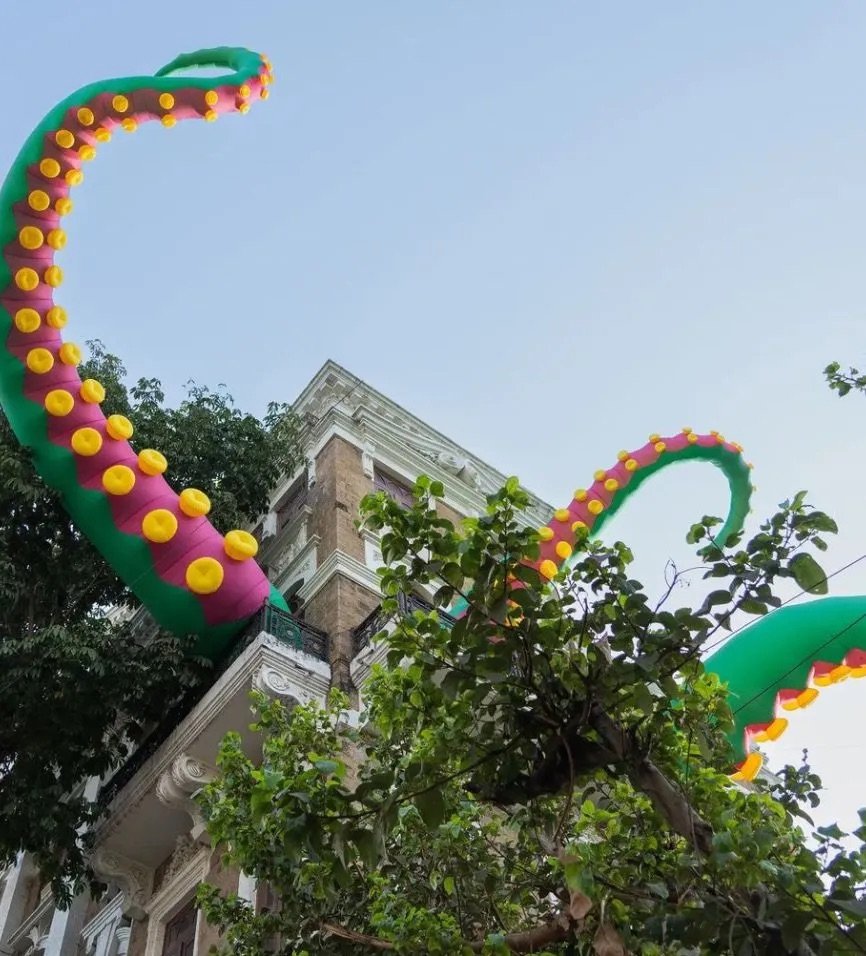Voicing the stories of community: Mumbai Urban Art Festival
A pungent smell fills the air, roadside sellers and customers bargain in Marathi (an Indian native language), and Mumbaikars hustle rapidly to catch the best fish for their meal at Mumbai’s busiest fishing dock. At the Sassoon port, very few would have imagined that an art landscape would be created but also thrive.
The exterior of the warehouse at Sassoon Dock, which is hosting Part 1 of the Mumbai Urban Art Festival. Credit: Ambica Sharma.
The Koli community of Mumbai are the original inhabitants of the land who continually have spent weeks sieving through the Arabian Sea to feed the massive population of the city. In recent years the community has faced the brunt of a regressive supply chain as commercial fishing by large corporations who have been stripping away the area from them. The overhead burden of permissions, licenses and destruction of mangroves has led to the Koli community losing their heritage and slowly being pushed out at the Sassoon docks. Thus, the concerns of the Koli community needed to be urgently vocalised.
As a result, Mumbai Urban Art Festival (MUAF) by St+Art India Foundation closed in February 2023. The finely executed MUAF at the Sassoon docks captures the buzzing economic capital of India through a community art initiative. Here one can witness installations created by sixty local and international artists who make a steadfast effort in cultural regeneration in the heart of the Maximum city. While journeying towards the docks, one can view murals inspired by the Koli community as well as other experiential, interactive art built on the theme “Between the Sea and the City.”
Arjun Bahl, one of the four co-founders at St+Art India, believes that the purpose of community-oriented art lies in enabling the process of healing in harsh environments through visuals and dynamic surroundings. Through the MUAF, St+Art India aims to enter contained niche spaces and convert them into centres overflowing with creativity and entertainment. Thus, its mission is to enable the willingness of people to change the urban landscape and tight infrastructure through art, as described by Arjun in an interview with MADE IN BED.
Art Mural showing life of Fish market on exterior of the warehouse at Sassoon Dock as part of Mumbai Urban Art Festival (MUAF). Courtesy: Condé Naste Traveller.
Arjun worked in events management and production for more than a decade. He expresses an unusual sense of gratification and meaning by creating these meaningful spaces for people of the country solely driven by passion. St+Art India Foundation has successfully disrupted a traditional approach towards the art world and exerted leaps and bounds since 2013 by engaging communities and making space for disparate voices.
“A community means a commune for all. It does not necessarily mean economic inclusion because that difference in a landscape like India will always exist. Our aim is to go beyond those economic disparities and includes all citizens based on the emotional intelligence of the community at Sassoon docks”, says Arjun on being asked what the term ‘community’ means to him. India is an energetic ground for community-oriented projects, and many artists have contributed to their own distinctive voices and combined their efforts that reek of revolution. We stand at a very interesting point in the Indian art world, where the sector is expanding from an elitist class to a tool of social and ecological empowerment.
Artist: Andha Ras. Photograph by: Sohil Belim.
So, what does community art mean in India today? For starters, it is a bunch of complex challenges.
On tackling challenges whilst making community projects in India, Arjun says, “If there are no complexities, there is no use in doing the project. The complexity itself makes a project like MUAF worthwhile, where you go into atypical public spaces and ditch conventional event venues. Challenges in producing public projects in India largely lie in the funding, space, management and navigating issues around intertwined realities that coexist within the same space. The vision here is to do projects in places that are out of the way and not frequently visited by its own people.”
Mumbai Urban Art Festival (MUAF), 2023.
Sajid Wajid Shaikh and Ronak Soni, Pipes and Leaks.
Photo Credit: Sohil Belim.
The foundation promises to do the ‘festival' every two years and restrains from calling it a biennale so that it psychologically echoes with the crowd that it is made for.
Overcoming these challenges in the most populated country in the world has made MUAF a trailblazer in initiating conversations about inclusion and diversification and enabling people to take action through traditional performance art, art district walks, and talks fueled by community engagement. MUAF interestingly created an inclusive space for the elderly people of the city who might be psychologically struggling with loneliness through collaboration with the Good Fellows organisation under the festival. Looking towards the future, Arjun believes that in 2023, the practice of inclusion itself needs to be expanded.
On this, “We chose themes that are around them and affect these communities on a daily basis. Doing workshops and talks has been an important first step to understanding and infiltrating these communities. This is a conscious choice to establish ownership between people and their immediate spaces”, says Bahl.
Artist: Filthy Luker. Photograph by: Sohil Belim.
Although the heart of the project remains situated at Sassoon port, MUAF was also spread to other locations like Bandra, Mahim and Colaba that account for mainland Mumbai. Artists like Vadeya Brothers, Luzinterruptus, Andha Ras, Serge Attukwei Clottey, Rero, Sajid Wajid Shaikh and Ronak Soni, amongst many others, have created AV installations, wall murals and waste-made installations that continue to glisten the stories of native dwellers intertwined with the city’s seascape.
Fundamentally, the initiative by St+Art India has not only opened a path for citizens to engage with their surroundings through art but also paved the way for government bodies to creatively support the well-being of its people.
Shubhi Gupta
Contributing Writer, MADE IN BED






